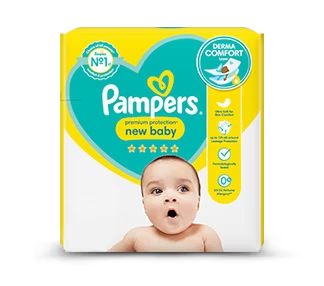What is Vernix Caseosa? Benefits for Your Newborn's Skin
Vernix caseosa is a natural, white, waxy coating that covers a newborn’s skin in the final weeks of pregnancy. Often described as 'cheese-like', it plays a vital role in protecting the baby from the womb through to the early days after birth. It’s made up of water, lipids and proteins, forming a protective barrier against amniotic fluid, helping to keep the baby’s skin from wrinkling, drying out or becoming chapped.
Vernix isn’t useful only at birth; its benefits also extend well beyond that moment. It can provide antimicrobial protection, help regulate your baby’s temperature and support the skin’s healing and moisture balance as they acclimatise to life outside the womb.
Key benefits of vernix caseosa:
Protects foetal skin from prolonged exposure to amniotic fluid
Contains antimicrobial and anti-inflammatory properties
Eases passage through the birth canal
Helps newborns regulate their body temperature
Moisturises and supports skin healing after birth.
Given these protective qualities, many healthcare professionals now support delaying a baby’s first bath to allow time for the vernix to absorb naturally into your little one’s skin.
In the sections that follow, we’ll explore the science, evolving recommendations and the vernix caseosa benefits, including how this white substance on newborns supports your baby’s health from the outset.
What Is Vernix Caseosa?
Vernix caseosa, usually simply called vernix, is the pale, creamy coating you may notice on your newborn’s skin in the first moments after birth. The term vernix caseosa literally translates as 'varnish of a cheesy nature', and it’s a perfectly fitting description. This pale, waxy coating on newborns can appear quite thick, like a natural moisturiser.
Vernix begins to cover your baby’s skin during the second trimester. At around 20 weeks of pregnancy, your baby will be covered from head to toe in a white, greasy layer of vernix. During the rest of your pregnancy, the thickness of the vernix layer will increase to reach its peak at 36-38 weeks. By around 40 weeks, it is mainly found in the skin creases. Your baby may come out covered in vernix, or it may already be mostly gone by the time they greet the world.
Vernix caseosa in newborns is simply a creamy, greasy substance mainly made up of water, lipids, and proteins. It contains enzymes and other innate immune proteins with antibacterial properties, protecting your baby's skin from constant exposure to amniotic fluid, preventing it from becoming too soft or waterlogged.
Babies Born with a Lot of Vernix
Once a baby is born, you may notice vernix still on their skin, especially if they arrived a little early. That white coating isn't just leftover birth residue, but it continues to help protect their delicate skin after birth.
If your baby is born with a generous amount of vernix, don’t worry, it's completely normal and often a good sign of a healthy or slightly premature birth. This creamy coating acts as a gentle moisturiser and may help regulate their body temperature during those first hours after birth.
Babies Born Without Vernix
You may notice that your baby is born without vernix or with only tiny patches. In full-term or post-term babies, vernix caseosa usually starts to wear off in the final weeks of pregnancy, so it may not be visible at birth.
By the time vernix naturally decreases, your little one's skin has already benefited from its protective properties inside the womb. However, if you have any concerns about your baby’s skin condition or appearance at birth, consult your baby’s midwife, GP or health visitor for guidance.
Benefits of Vernix
You can think of vernix caseosa as your little one’s first line of defence. This creamy white coating doesn’t just protect your baby’s skin in the womb; it continues to offer unique support in the early hours after birth. The benefits of vernix extend far beyond the surface of the skin.
Vernix caseosa is more than a moisturiser — it forms a protective biofilm, provides a natural antibacterial barrier, and even helps deliver beneficial components to the skin. Its texture and composition help protect and support a newborn's skin, and assist in temperature regulation. For this reason, many parents and healthcare professionals emphasise leaving vernix on the baby's skin rather than washing it off immediately.
The Benefits of Vernix Caseosa in the Womb
Long before birth, vernix caseosa begins its important work—shielding your baby’s skin and supporting healthy development in the womb. In utero, its benefits include:
Protecting the foetus from damaging substances, such as urea and electrolytes, in the amniotic fluid.
Helping with thermoregulation.
During vaginal delivery, vernix serves as a lubricant, protective biofilm, and antimicrobial barrier against bacteria in the genital tract.
The Benefits of Vernix Caseosa After Birth
Even after your little one is born, vernix caseosa benefits continue to make an impact:
It acts as a natural moisturiser
Rich in water and lipids, vernix can help lock in moisture and prevent your newborn's skin from becoming dry or cracked.
It may have antibacterial properties
This white coating may offer a protective barrier against harmful bacteria in the first hours after birth.
It has antioxidant properties
Vernix contains antioxidants like vitamin E and melanin, which help slow down cell damage due to free radicals.
How Long Should You Leave Vernix Caseosa on Your Baby?
Historically, hospitals and birthing centres often bathed newborns within the first hour or two after birth. That approach is changing as guidelines evolve. Growing evidence suggests that delaying a newborn’s first bath and keeping vernix caseosa on the skin for longer offers real benefits.
When your baby is born, they may be covered in amniotic fluid, traces of blood, and visible vernix. It’s completely natural to want to clean them up.
The World Health Organisation (WHO) recommends waiting at least six hours before bathing your newborn and ideally waiting about 24 hours. The WHO also recommends not wiping off the vernix at birth.
The NHS recommends only using plain water to clean your baby during their first month.
The main reasons to wait on your baby’s first bath include:
Keeping your little one warm and stabilising blood sugar levels
Babies bathed too soon after birth are more likely to become cold and could develop hypothermia. The stress of having a bath right after birth could also cause a drop in blood sugar levels.
Allowing time for breastfeeding and bonding
The 'golden hour' after birth is ideal for skin-to-skin contact and parent-child bonding. This shared time can also help with early breastfeeding.
Helping prevent dry skin
Leaving vernix on the skin helps retain moisture and may reduce the risk of dryness or irritation. This is one of the most practical and protective vernix caseosa benefits in the hours after delivery.
If you’re unsure about the best approach for your baby’s first bath, you can talk to your little one’s midwife or doctor at the hospital. They can guide you based on your baby’s condition and your personal preferences.
Newborns can sometimes have sticky eyes after birth, usually caused by vernix irritating the eyes. In most cases, regular eye care is all that's needed. If your baby's eyes stay sticky, please inform your midwife or GP.
Vernix Caseosa and Lanugo
In addition to vernix, you might also notice a fine, downy layer of hair on your baby’s skin at birth; this is called lanugo. It's completely normal and may come as a surprise, especially if it's your first time seeing a newborn up close.
Lanugo covers your little one’s skin during the latter part of your pregnancy and usually sheds before birth. Lanugo is the first type of hair your baby has!
Lanugo starts to cover your baby’s skin at around 21 weeks pregnant and usually disappears before birth. The purpose of lanugo is not fully understood, but it is thought to help keep your baby at the right temperature in the uterus.
Although lanugo doesn’t usually last until birth, some babies are born with small patches of it here and there. If your little one greets the world with some lanugo still on, it will usually be shed within a week or two.
Whether your baby has a full coating of vernix, a patch of lanugo, or both, these features are all signs of your baby’s development and journey through the final stages of pregnancy. If you’re ever unsure whether something on your newborn's skin is typical, reach out to your baby’s healthcare professional for peace of mind.
FAQS AT A GLANCE
Historically, newborns were bathed soon after birth, typically within the first couple of hours. Today, experts advise delaying the bath and letting vernix stay on the skin to promote bonding, keep your baby cosy, and protect their skin from drying out.
The Bottom Line
Before birth and in the first hours after delivery, vernix caseosa provides your baby with notable protective benefits.
If you can, delay your baby's first bath for at least six hours, ideally up to 24 hours, in line with World Health Organisation guidance. That pause lets your baby soak up the vernix and gives you both space to bond—skin-to-skin contact, early feeds, and a bit of rest.
Very soon, your newborn will be clean and cosy, all ready for cuddles. In the meantime, that white vernix is quietly doing a vital job, shielding their delicate skin in these early days.
For more information on baby skin care, read up on caring for delicate newborn skin. And while you’re here, get ahead of the game by downloading the Pampers Club app for exclusive rewards and discounts on your nappy purchases.
The information in this article is based on the expert advice found in trusted medical and government sources, such as the National Health Service (NHS).The content on this page should not replace professional medical advice. Always consult medical professionals for full diagnosis and treatment.
Read more about Newborn Baby
Join Pampers Club and get:




